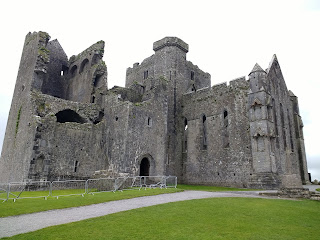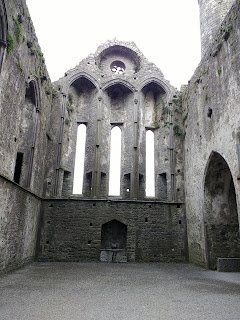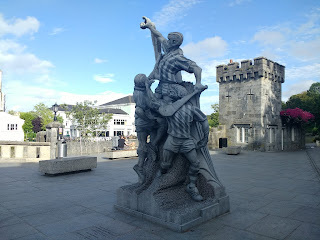Rather than first seeing the sights in the town of Kilkenny the morning after we arrived, we hightailed it to the famous Rock of Cashel over in County Tipperary to avoid as many of the bus crowds at the Rock as possible. It had been drizzling the entire drive from Kilkenny west to Tipperary but we lucked out the moment we arrived as the rain stopped even if the sun didn't also make an appearance!
In the basement of the youngest building on the Rock was the Hall of the Vicars Chapel which would have been the storage room for the vicars or less important clerics selected to sing during cathedral services. The 17th century Flemish tapestry showed King Solomon meeting with the Queen of Sheba. It was put up for decoration and also to provide warmth and insulation in the otherwise chilly room, our guide mentioned. The tapestry's border didn't go all the way around so it may once have been part of a much larger piece.
The guide pointed out the 'mistake' in the otherwise appealing big brown tapestry as only God was perfect and therefore the weavers intentionally chose to overemphasize the woman's midriff in the figure on the right!
The most important exhibit was the original 12th century St. Patrick's Cross that used to stand outside by the Cathedral but centuries of wind and rain caused too much damage so it was moved inside for safekeeping. It was unusual among Irish high crosses because it didn't have a ring around the cross' head to support its arms and to symbolize the sun which made Christianity more acceptable to the sun-worshipping Celts. The base of the cross was hollow so items of wealth and importance could be hidden inside. It was amazing to see the original even if its details weren't very distinct.
I thought that the depictions of the angles representing choir members that adorned the walls in the chapel were rather ghoulish.
The guide noted that the original walls had a white lime wash to provide as much light as possible in the dark room and also to prevent mold.
NO nails, only wooden pegs, were used on the roof.
Outside we saw the limestone replica of the cross. Like other similar crosses, there was a figure of the crucified Christ on one side clad in a full length robe and a figure of an abbot on the other. One the side was one of the vertical beams or supports that represented the two criminals who were crucified beside Christ; the other was lost.
From another angle:
Our guide, Magella, told the group that none of the buildings remained from the 4th century; these were all from the 12th century. Normally churches were constructed so they faced east toward Jerusalem but the massive Cathedral had to be squeezed in between the existing chapel, the round tower and drinking well which resulted in a cramped nave where the clergy met to celebrate Mass.
Magella pointed out the 'lepers' squint' on the upper right so unsightly lepers could see the altar during Mass without causing concern to the congregation.
There were some striking views over the Tipperary Plain as we walked around the Cathedral.
When Queen Elizabeth II and Prince Philip made a state visit to the Rock of Cashel on May 20, 2011, as part of the first royal visit to the Republic, their helicopter landed in the adjacent field next to the 13th century Cistercian Abbey.
Magella stated it was decided in 1930 which locals could be buried in the cemetery surrounding the Cathedral and that there are only nine or ten on that registry still alive.
The 27-meter high Round Tower dated from 1101 and was likely used for storage but would also have had religious significance as a place of worship and learning.
The location of the Rock of Cashel was very imposing overlooking the farmlands; its historical importance was obviously significant; and the Irish high crosses were stunning to behold but, in hindsight, if we'd been pressed for time, I would have bypassed the long drive to the Rock. Whether I'm becoming more discriminating, tougher to please or whether Irish marketing authorities have done too good a job - I don't know.
Unlike most countries we've traveled to that have only had a senior discount for that country's nationals, the OPW offers 'concession' discounts to 'old people' from all over!
We first entered the West Tower where we could see the massive depth of the walls in the 13th century circular room. There were two arrow loops or slits in the walls that allowed an archer to shoot attackers outside.
The ceiling had an example of wicker willow left over from the wicker structure used to support the vault during construction.
The Chinese Withdrawing Room - so called as 19th century etiquette demanded that women withdraw after dinner so men could indulge in such unladylike habits as smoking cigars and drinking port - still had some original sections of hand-painted Chinese wallpaper from 1810.
The State Dining Room was the castle's formal dining room until the 1860s when it became the billiard room! Not to worry, though, the noblemen and ladies still had another dining room.
Lovely views out to the gardens from the dining room aka billiard room, I thought.
The black and white stone floor of the Entrance Hall was laid with Kilkenny black marble.
The North Tower's Tapestry Room was the most exquisite so far in my opinion with its unusual keyhole shaped ceiling and glorious tapestries. They were part of a series titled The Story of Decius Mus woven from designs by Peter Paul Rubens after 1616. They depicted the story of Mus, a Roman Consul who sacrificed himself to enable the victory of the Romans against the Latins.
The interior decoration of the Library was a faithful recreation of the furnishing style of the mid to late 19th century. Because a fabric remnant was found, the stunning French silk poplin on the walls was reproduced in its original pattern and color by a firm in Lyons, France. I shuddered to think the price of that order as the same wall covering was also used in the Anteroom and Drawing Room, seen after the library.
We have been in goodness only knows how many palaces or castles by now but never had there been any description about the level of research needed to restore any of the materials or furniture. I found that detail of great interest at Kilkenny Castle.
The Bedroom Corridor had been a Gallery in the 16th and 17th centuries when the Butler family ha a collection of 500 paintings, the largest in Ireland.
The Victorian Nursery provided a fascinating glimpse into 19th century childhood with period appropriate furnishings and everything one might imagine a privileged child of that era to have.
The Chinese Bedroom also caught my eye as it was decorated with a modern reproduction of hand-painted Chinese wallpaper. I was able to chat with one of the castle guides who mentioned that Europeans had been very taken with all things Chinese which explained the number of Chinese artifacts in that room and also in the Withdrawing Room we'd seen earlier.
Check out the paintings under the framing by clicking on the photo so you can see a much larger version of it.
The castle was perched above the peaceful River Nore down which I saw boats being paddled.
The castle courtyard:
As I mentioned in another post, the flowers in public spaces including parks, bridges and every other imaginable spot we've seen so far in Ireland have been among the most plentiful and gorgeous of anywhere in the world. I applaud the care, love and huge amounts of money that have been devoted to making their country such a beautiful one to visit.
The Carnegie Library:
Until we crossed over into County Clare this afternoon from County Kerry, we would have been hard pressed to drive more than a mile or two since arriving in Dublin and not see banners and flags on virtually every house and in every store and up and down city streets declaring one's allegiance for a county sports team. I have never seen sports loyalty or madness to this degree anywhere!
Next post: Abbeys, tapestries and the Kennedys!
Posted on September 11th, 2019, from Galway on the west coast of Ireland.




























































This post immediately reminded me of my mom's favourite war time songs "It's a long way to Tipperary". And the photos of the majestic Kilkenny Castle and manicured courtyard are wonderful. Thanks Anne for the memory of mom and the splendour of the castle ! xo
ReplyDelete